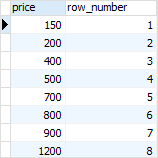PostgreSQL ROW_NUMBER Function
Summary: in this tutorial, you will learn how to use the PostgreSQL ROW_NUMBER() function to assign a unique integer value to each row in a result set.
Introduction to the PostgreSQL ROW_NUMBER() function
The ROW_NUMBER() function is a window function that assigns a sequential integer to each row in a result set.
The following illustrates the syntax of the ROW_NUMBER() function:
ROW_NUMBER() OVER(
[PARTITION BY column_1, column_2,…]
[ORDER BY column_3,column_4,…]
)The set of rows on which the ROW_NUMBER() function operates is called a window.
The PARTITION BY clause divides the window into smaller sets or partitions. If you specify the PARTITION BY clause, the row number for each partition starts with one and increments by one.
Because the PARTITION BY clause is optional to the ROW_NUMBER() function, therefore you can omit it, and ROW_NUMBER() function will treat the whole window as a partition.
The ORDER BY clause inside the OVER clause determines the order in which the numbers are assigned.
PostgreSQL ROW_NUMBER() function examples
We will use the products table created in the PostgreSQL window function tutorial to demonstrate the functionality of the ROW_NUMBER() function.
 The following shows the data in the
The following shows the data in the products table:
 See the following query.
See the following query.
SELECT
product_id,
product_name,
group_id,
ROW_NUMBER () OVER (
ORDER BY
product_id
)
FROM
products; Because we did not use the
Because we did not use the PARTITION BY clause, the ROW_NUMBER() function considers the whole result set as a partition.
The ORDER BY clause sorts the result set by product_id, therefore, the ROW_NUMBER() function assigns integer values to the rows based on the product_id order.
In the following query, we change the column in the ORDER BY clause to product_name, the ROW_NUMBER() function assigns the integer values to each row based on the product name order.
SELECT
product_id,
product_name,
group_id,
ROW_NUMBER () OVER (
ORDER BY
product_name
)
FROM
products; In the following query, we use the
In the following query, we use the PARTITION BY clause to divide the window into subsets based on the values in the group_id column. In this case, the ROW_NUMBER() function assigns one to the starting row of each partition and increases by one for the next row within the same partition.
The ORDER BY clause sorts the rows in each partition by the values in the product_name column.
SELECT
product_id,
product_name,
group_id,
ROW_NUMBER () OVER (
PARTITION BY group_id
ORDER BY
product_name
)
FROM
products;
PostgreSQL ROW_NUMBER() function and DISTINCT operator
The following query uses the ROW_NUMBER() function to assign integers to the distinct prices from the products table.
SELECT
DISTINCT price,
ROW_NUMBER () OVER (
ORDER BY
price
)
FROM
products
ORDER BY
price; However, the result is not expected because it includes duplicate prices. The reason is that the
However, the result is not expected because it includes duplicate prices. The reason is that the ROW_NUMBER() operates on the result set before the DISTINCT is applied.
To solve this problem, we can get a list of distinct prices in a CTE, then apply the ROW_NUMBER() function in the outer query as follows:
WITH prices AS (
SELECT
DISTINCT price
FROM
products
)
SELECT
price,
ROW_NUMBER () OVER (
ORDER BY
price
)
FROM
prices; Or we can use a subquery in the
Or we can use a subquery in the FROM clause to get a list of unique prices, and then apply the ROW_NUMBER() function in the outer query.
SELECT
price,
ROW_NUMBER () OVER (
ORDER BY
price
)
FROM
(
SELECT
DISTINCT price
FROM
products
) prices;
Using the ROW_NUMBER() function for pagination
In application development, you use the pagination technique for displaying a subset of rows instead of all rows in a table.
Besides using the LIMIT clause, you can use the ROW_NUMBER() function for the pagination.
For example, the following query selects the five rows starting at row number 6:
SELECT
*
FROM
(
SELECT
product_id,
product_name,
price,
ROW_NUMBER () OVER (
ORDER BY
product_name
)
FROM
products
) x
WHERE
ROW_NUMBER BETWEEN 6 AND 10;
Using the ROW_NUMBER() function for getting the nth highest / lowest row
For example, to get the third most expensive products, first, we get the distinct prices from the products table and select the price whose row number is 3. Then, in the outer query, we get the products with the price that equals the 3rd highest price.
SELECT
*
FROM
products
WHERE
price = (
SELECT
price
FROM
(
SELECT
price,
ROW_NUMBER () OVER (
ORDER BY
price DESC
) nth
FROM
(
SELECT
DISTINCT (price)
FROM
products
) prices
) sorted_prices
WHERE
nth = 3
);
Summary
- Use the PostgreSQL
ROW_NUMBER()function to assign integer values to rows in a result set.